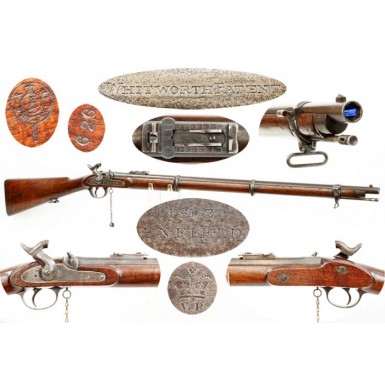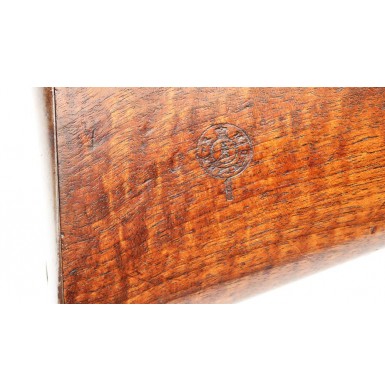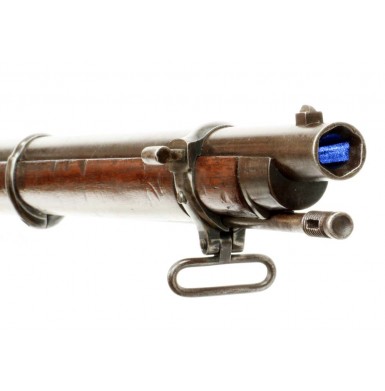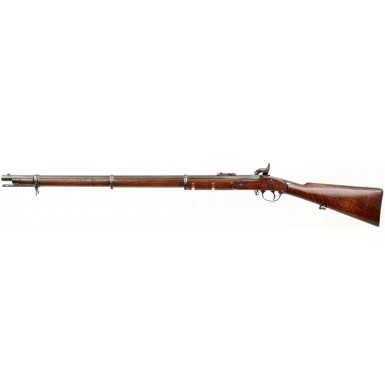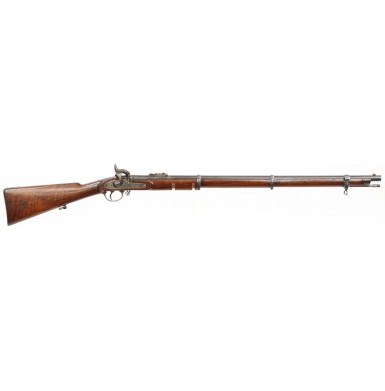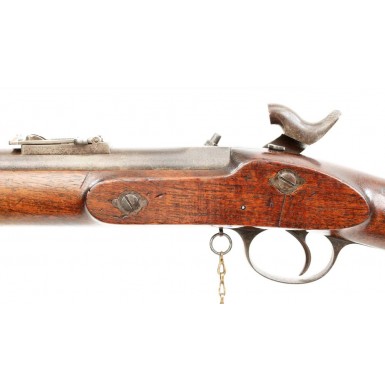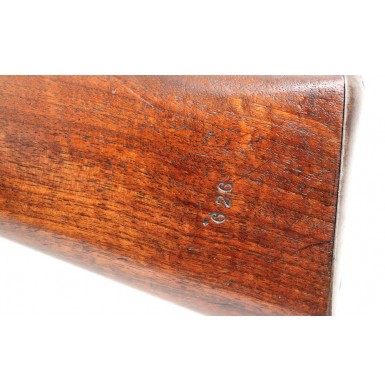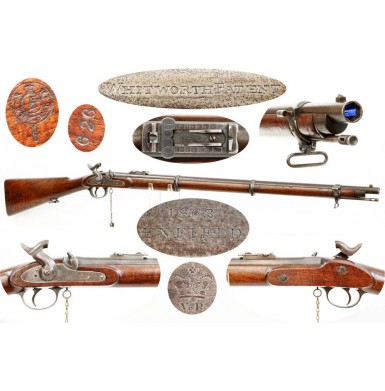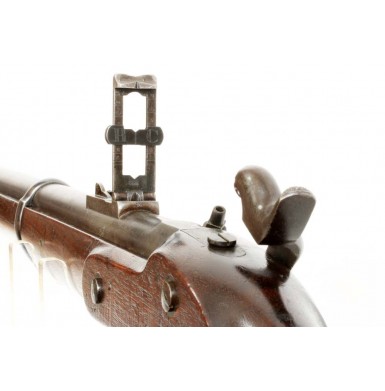British Military P-1863 Whitworth Rifle
- Product Code: FLA-3256-SOLD
- Availability: Out Of Stock
-
$0.00
There is probably no muzzle loading rifle more renowned for accuracy than the Whitworth Patent Rifle. Sir Joseph Whitworth was an incredibly talented engineer who was responsible (among his many innovations and inventions) for the establishment of the first standardized thread system for screws. This is something we tend to take for granted today, but the standardization of thread count, thread pitch and screw diameter was a revolutionary idea during the mid-19th century when screws were handmade and hand cut. His reputation for being able to produce machines with tight tolerances lead the British Board of Ordnance to approach him in 1854 to help with the design and manufacture of the machinery that was needed for the Royal Small Arms Factory at Enfield Lock. This facility would be the first one in England to produce small arms on the principle of interchangeable parts, a production method that had been pioneered in America by such companies as Colt’s Patent Firearms and Robbins & Lawrence. Subsequently, the Board of Ordnance asked Whitworth to provide input for potential improvements that might be obtained in rifled small arms barrels. To this end, Whitworth consulted prominent gunmaking engineers like Charles Lancaster (who developed the “oval bore” mechanical rifling system) and Westley Richards (who was working with an octagonal bore mechanical rifling system). Whitworth’s interest in precision machining and in the potential for improved accuracy of firearms lead to his adoption of a polygonal, 6 sided, mechanical rifling system that proved to be extremely accurate. While he cannot be directly credited with the invention of the 6-sided mechanical rifling system, he can be accurately considered to have substantially improved it in such a way as to make it extremely successful. Much of his design accuracy was due to his work with the projectile, which he designed to be longer and smaller in diameter than the typical musket bullet of the day, yet retaining the weight of a military service type bullet. His 530 grain, .451 caliber hexagonal bullet did not depend upon unreliable expansion of a hollow base in order to engage the rifling of the bore, but instead replied upon the tight mechanical fit of his bullet to the .451 polygonal bore. The end results were simply stunning accuracy for a muzzle loading firearm, with one test resulting in a 12” group at 1,800 yards; a group shot at just over 1 mile with a black powder muzzle loading rifle. These are the kinds of marksmanship results that are expected from today’s highly accurized bolt-action sniper rifles in .50BMG and .338 Lapua, not a 19th century muzzleloader. Whitworth began manufacturing his revolutionary rifles in 1857 and in 1860 formed the Whitworth Rifle Company in Manchester, England. Initially, the majority of his customers were serious target shooters, who were interested in obtaining the most accurate rifle of the period. He produced the rifles in a variety of styles from cased multi-barrel sets to military style match target rifles, and everything in between. In 1862 Whitworth’s company was reorganized as the Manchester Ordnance & Rifle Company. There is probably no more famous, nor more desirable, variant of the Whitworth Rifle than the handful that were purchased by the Confederacy during the American Civil War. These guns were put to devastating use against the Union Army, particularly the officer corps and against artillerymen. These guns were all “2nd Quality” Military Match Rifles, and at least some of the later deliveries were equipped with 4-power Davidson telescopic sights, while earlier deliveries used Whitworth’s conventional rear sights and “globe” front sights. It is unlikely that more than 50 of the rifles were imported during the course of the war, but the legendary stories of their use and great accuracy have made them an iconic piece of American arms collecting history. While the Confederacy was actively attempting to acquire the extremely accurate and expensive rifles during 1861 and 1862 (Major Anderson of the Confederacy noted they were to have cost as much as “$1,000, in the equivalent of gold, for reach rifle and one thousand rounds of ammunition.”), the British military was still exploring the possibilities of the Whitworth design. The Board of Ordnance had already experienced good results in testing other mechanical rifling systems, as their Brunswick rifles had worked well in the past, and the oval bore design of Charles Lancaster had almost been adopted over the 3-groove, progressive depth rifling used on the P-1853 Enfield Rifle Musket. The board, however, understood that there were certainly advantages to Whitworth’s smaller bore size and tight tolerance mechanical fit projectile. Whitworth explored numerous variations of his polygonal design for the Board of Ordnance from 1858 to 1862 and produced many experimental rifles, which varied in barrel length, rate of twist, barrel material, etc. in an attempt to find the perfect combination of accuracy, handling, weight and durability. The first rifles to be produced in any quantity were officially designated the Pattern 1862 Whitworth Rifle. These rifles were all produced at the Royal Small Arms Factory at Enfield Lock (R.S.A.F.) with 36” iron barrels, 6-sided polygonal rifling, in .451 caliber (52 bore) with a 1:20” rate of twist, and were intended to look very much like the Pattern 1853 Enfield rifle musket then in general use. The iron mounted rifle used the same lock as the Pattern 1860 Enfield Rifle (then in production at RSAF and among various contractors), as well as much of the same furniture, such as the buttplate, trigger guard, etc. The rifle used 3-barrel bands rather than the two that was standard on the 33” barreled service rifles then in production. These 1,000 rifles were utilized in various field tests, and were commented upon favorably enough for the Board of Ordnance to authorized the production of 8,000 more rifles for field trials. These rifles, which would become the Pattern 1863 Whitworth Rifle, had slightly shorter barrels, at 33”, due to the fact that the barrels were made of steel rather than iron, and consequently weighed more than their iron counterparts. The new P-1863 also incorporated some minor improvements in the rear sight, and introduced a bayonet lug on the upper barrel band to accept a bayonet based upon the Pattern 1856 saber bayonet. The reason the bayonet lug (“bar” in English terminology) was placed on the upper barrel band rather than directly on the barrel was the belief that it would be too difficult to adequately weld the bayonet lug directly to the steel barrel. As a result, the upper band was of the wide variety with a transverse pin through the band and stock for additional support. This pattern of barrel band had been introduced for the P-1856 Type II (also known as the P-1858) “Bar on Band” series of rifles. These 8,000 Whitworth patent rifles were produced at R.S.A.F. and were issued to a large number of regiments for field trials. In general, 68 of the rifles were issued each of the regiments that received them for the trials (possibly to equip the “light companies”), and field reports were to be complied regarding the rifles in service performance over the next few years. At least 12 regiments not in service in India were issued the new P-1863 Whitworth Rifle, including the 2nd Battalion Grenadier Guards, 1st Battalion Scots Fusilier Guards, 1st Battalion 3rd Foot, 2nd Battalion 5th Foot, both 1st & 2nd Battalion of the 60th Rifles and the 73rd Foot. Five additional regiments in Indian service were also issued the rifles, including the 42nd Highland Foot and 2nd Battalion Rifle Brigade. In general, the reports from the field were quite similar. The rifles tended to foul badly when used in hot environments. In many cases it was difficult for the average solider to ram more than a half-dozen rounds before the rifle became too fouled to load. When combined with the much higher cost per unit versus a standard P-1853 Enfield rifle musket, as well as the slower rate of fire, it quickly became obvious that the P-1853 was more than sufficient for the typical needs of the line infantry, and even though the Whitworth had tremendous advantages in accuracy, it was not a practical weapon for general issue. Although the guns remained in limited experimental issue through 1867-1868, with many regiments testing them, the guns were never considered a potential replacement for the P-1853 Enfield. In the end, the Whitworth design became an anachronism that proved the potential for smaller bore rifle accuracy, but at a time when the age of the muzzle loader was coming to an end and the metallic cartridge breechloader was about to change the world of warfare forever. The Pattern 1863 Whitworth rifles were subsequently returned to storage and eventually sold as surplus, becoming a footnote in the history of 19th century British military small arms development. While the rifles never made a significant difference in the British military, they did manage to gain iconic status in the hands of a few Confederate sharpshooters, and at the shooting competitions at Wimbledon, insuring that the Whitworth Rifle would never be merely a footnote to arms historians and arms collectors.
This British Pattern 1863 Whitworth Military Rifle is in about VERY GOOD+ to NEAR FINE condition and is a very crisp example of one of the 8,000 rifles authorized for production at R.S.A.F. in 1863. The lock of the rifle is marked with the usual British (CROWN) to the rear of the hammer, over the letters V.R. for Victoria Regina, and indicating British government ownership. Forward of the hammer, the lock is marked 1863/ ENFIELD, and with a small (CROWN-BROAD ARROW) / S-R and with a very small 3. The obverse buttstock bears the expected R.S.A.F. storekeepers mark, a roundel that reads - R (CROWN) M “ ENFIELD in a circle around the inspection mark E / (CROWN) / 15 (inspector #15 at Enfield), all of which is over the number 1. The “1” indicates the rifle was “1st Class’ and made with interchangeable parts. The reverse of the butt is stamped with the number 626, and may be a storekeepers number of production number. If it is a production number, it means this is one of the earliest P-1863 Whitworth Rifles. As the guns were typically issued in groups of less than 100 to each regiment, it is not likely to be a regimental rack number, nor is it stamped in the way in which British military regimental marks are usually applied. The top of the breech is engraved WHITWORTH’s PATENT between the end of the nocksform and the base of the rear sight. The bottom of the barrel is unmarked. The interior of the lock bears the usual plethora of British military inspection marks with E / (CROWN) / # marks on the various parts, with inspectors’ number 2, 3, 16 and 27 represented. As noted, the rifle is in VERY GOOD+ to NEAR FINE condition. The barrel has a pleasing plum brown patina with some flecked traces of original finish present on the outer surfaces. The underside of the barrel, where it has been protected by the stock, retains about 10%-20% of its original blue, which is dulling and fading. The balance of the rifle furniture has a smooth plum brown patina, matching the barrel surface, with the barrel bands retaining some strong traces of original blue as well. The metal is mostly smooth (forward of the rear sight) and shows some scattered pinpricking and some light surface oxidation along its length. The breech and bolster areas show more significant amounts of pinpricking and some very light pitting, and the area around the “WHITWORTH’s PATENT” mark has been lightly cleaned to make the mark clearer. The bore of the rifle is in VERY GOOD+ to NEAR FINE condition as well. The bore has a dull, dusky patina with scattered light pitting along its entire length. However, due to the system of mechanical rifling, versus traditional rifling grooves, this light pitting should have practically no effect on the accuracy of the rifle. The lock has a mottled smoky gray patina, a result of the original case hardened finish fading over time, with a small area of vibrant case coloring still visible forward of the hammer body, where it was protected from age and fading. The lock is mechanically EXCELLENT. The lock functions perfectly on all positions and remains in very crisp mechanical condition. The cone (nipple) appears to be original to the period of use, and shows wear and lightly oxidized pitting that matches the wear and erosion at the cone seat. An original, period “snap cap” (nipple protector) is attached to the tiny eyebolt forward of the triggerguard, to allow the soldier to dry fire his rifle without damaging the cone (nipple). The rifle retains its original rear sight, which is correctly marked and graduated for both types of ammunition issued with the guns. The sliding adjustment elevator on the sight is marked with an engraved C on the right hand side and an engraved H on the left hand side. These indicate that the right side graduations are for the use of “conical” (round) ammunition and the right hand graduations are for use with the “hexagonal” (six sided) ammunition. The conical side is graduated to 1,250 yards, while the hexagonal side is graduated to 1,350 yards. The sight is complete and fully functional. The original front sight is in place near the muzzle of the rifle as well. The original ramrod is in place in the channel under the barrel and is full-length with fine threads at the end. The original rear swivel is in place at the end of the extended iron triggerguard tang and the original upper swivel is attached to the upper barrel band. All of the hardware and furniture appears to be original to the rifle, with each barrel band inspected on its reverse with an E / (CROWN) / W, indicating Enfield inspection for use on a Whitworth rifle. The stock of the rifle is in about VERY GOOD+ to NEAR FINE condition as well. The stock is solid and full-length with no breaks, cracks or repairs noted. The stock remains crisp and sharp with a clear R.S.A.F. storekeepers’ roundel on the butt. The stock retains crisp edges and does not appear to have been sanded. The stock has a thin layer of old varnish that was applied to it long ago for protection. This does not in any way detract from the condition and presentation of the rifle, and could be easily removed if so desired. As would be expected, the rifle shows the usual minor bumps, dings, bruises and mars that are typical of a 19th century military gun stock that saw actual issue, service and use.
Overall this is very nice example of a fairly rare British Pattern 1863 Whitworth Military Rifle. For most collectors a British military Whitworth rifle or a civilian military match rifle are as close as they will ever get to owning the nearly mythical Confederate Whitworth (you might have a better chance of finding a unicorn than a real Confederate Whitworth”.). This is a very nice condition displaying example that is in good mechanical shape, and would probably shoot very well if you wanted to experience what a Whitworth can do. These British military Whitworth rifles do not come up for sale very often, and when they do, they always bring realize prices. This one shows real world use and was likely one of the guns that saw actual trial service in the field. The gun is the perfect combination of used, but well cared for condition that means it is not too minty to risk taking out to fire a little bit if you are so inclined. With really excellent examples of these rifles selling in the 5-figure range, this rifle is certainly one you will be proud to own and display, but without having to reach quite so deeply into your pocket to acquire. A correct pattern Whitworth Rifle saber bayonet and scabbard are available for the rifle as well, and will be listed on the site for sale as inventory number EWB-2212. This is only the third British P-1863 Whitworth Rifle I have been able to offer for sale in more than a decade. The first was a really mint 5-figure gun that lasted only a couple of days and never made it to the web site, and the other was a heavily used and partially restored example that also sold quickly for more than half of what this gun is priced at. Don’t miss your chance to own one of the most famous muzzle loading military rifles of the 19th century, as I don’t know when I will be able to offer one for sale again.
SOLD
